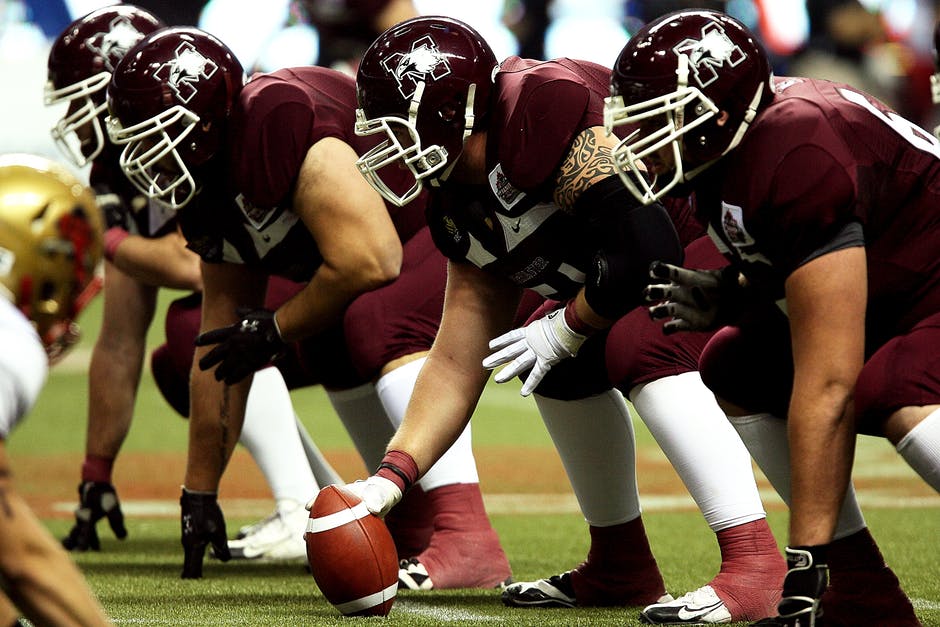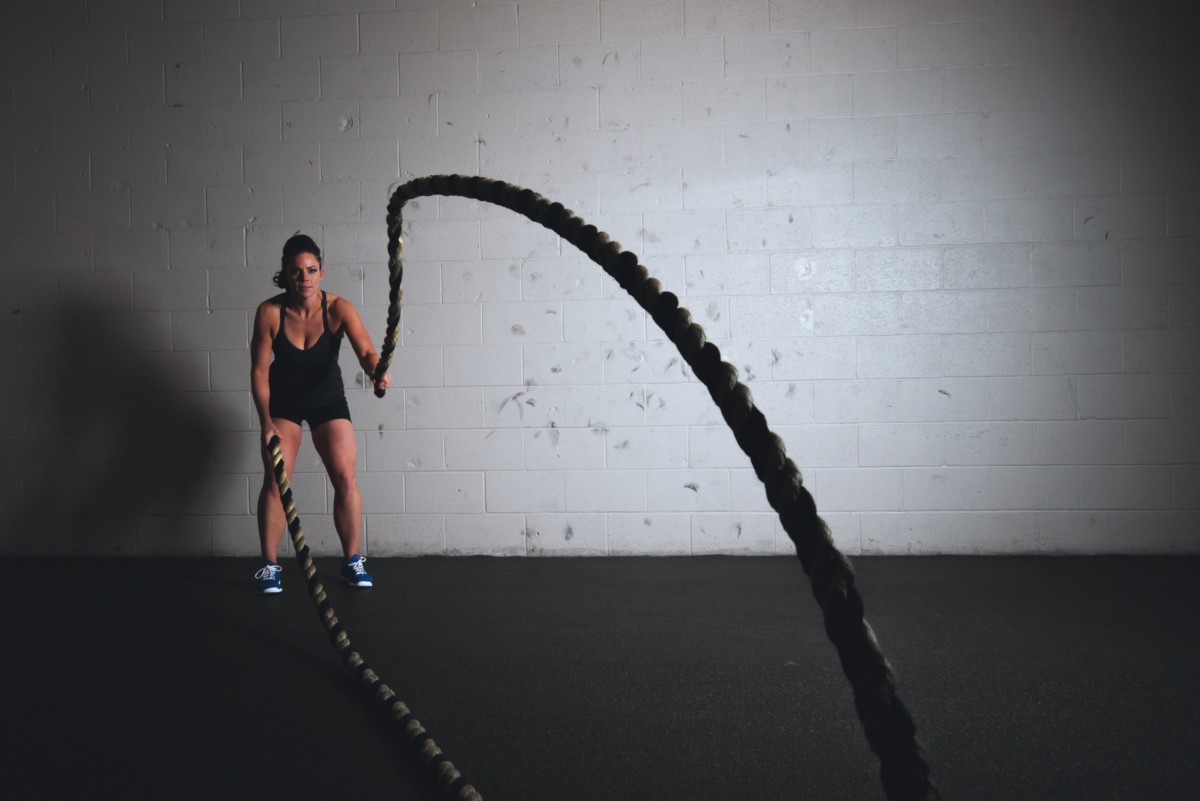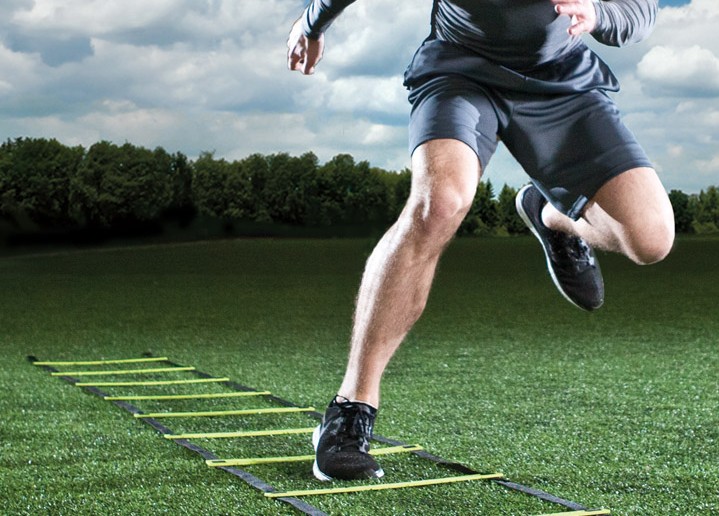However, there is a huge difference between training in a team setting (high school, college, even pro) and training in a facility with a one-on-one setting. A team setting may have 20-50 athletes training at one time with minimal supervision. While this may not be ideal, it’s a reality for many programs. In addition to having a large number of athletes training at one time, there is also limited time. For example, there are many high school programs that are going to try to train that number of athletes in 30-45 minutes.
Things to keep in mind:
With the above in mind, the following things that probably aren’t realistic for achieving our objectives:
- Dumbbells: Dumbbells are a great training tool in a strength and conditioning setting. They allow for each arm to work independently of the other, allow for greater range of motion, and allow for greater variety than barbells. However, in order to have enough to challenge a team you need to have a huge variety of dumbbells. For example, we’d like our football team to be performing dumbbell bench presses for sets of 8-12 repetitions. To do this, we need:
- 80-100 pound dumbbell sets for the offensive and defensive linemen
- 60-80 pound dumbbell sets for the receivers and linebackers
- 40-60 pound dumbbell sets for quarterbacks and kickers
- Enough of each of those sets for 1/3 or ¼ of the athletes to train together at one time
- Enough benches for the exercises to be done on
- Storage facility for all those dumbbells
- Dedicated space for all those dumbbells
- Not only is this incredibly expensive, it’s not the best use of space and time.
- Kettlebells: To use kettlebell exercises to increase strength and hypertrophy in a team setting you run into the same challenge you have with dumbbells, you need enough of each weight (and you need a wide enough variety of weights) to challenge athletes enough so that they achieve the desired adaptations. Add to the fact that kettlebells aren’t cheap, require a lot of storage space, require a dedicated space for exercises, and require specialized instruction and this won’t be a great use of time or resources – though it’ll look great on social media.
- Machine weights: Machine weights are effective at increasing strength and muscle mass. But, there are real challenges to using these in a team situation. First, each machine has a huge footprint. Having enough of them on hand for an entire team to be able to use in a program requires a lot of space. Second, each machine is a lot more expensive than free weights. Third, typically machines only allow for one or two exercises to be performed, so all that space and money is being used to be able to perform 1-2 exercises.
- Specialized benches: There are a lot of great specialized benches that can help with an athlete’s strength and conditioning. These include 90 degree benches (shoulder presses), incline benches, decline benches, glute-ham raise benches, reverse hyper benches, etc. Each of these is expensive, each requires space, and to properly use these in a team setting means you need to have a bunch of these to be effective.
- Specialized barbells: There are now a huge variety of different types of barbells available for strength and conditioning. Many of these are used in powerlifting and Olympic lifting. However, using these in a team setting can be problematic because you would need at least one of each type for each rack. So, for example, we like to do the following types of exercises:
- Regular squats (7’ barbell) ($200)
- Buffalo squats (really heavy squats) ($400)
- Safety squats ($400)
- Hex bar deadlifts ($200)
- That means we need each type of bar at each rack. So every rack would mean spending about $1200 in different barbells. Figure 10-20 racks and this gets really expensive quickly.
Now, if you have all this equipment and have been able to solve the challenges I mentioned then great for you!
On the other hand, the following pieces of equipment are ideal for this situation:
- Racks and platforms: Today’s racks allow for everything from Olympic lifts, to squats, to deadlifts, to presses, to suspension training, to dips and pull-ups to be performed in them. If the rack and platform are organized correctly, more than one athlete can exercise at a time. For example, one athlete performs power cleans on the platform while another squats in the rack. A third athlete could be performing suspension training and another 1-2 athletes can be spotting and loading.
- Barbells: Have 1-2 barbells per rack allows for groups of 3-4 athletes to train at each rack. Even if only 1 athlete exercises at a time, then one spots, the other two load, then the athletes rotate. This keeps them all busy and focused and maximizes the equipment.
- Suspension trainer units: Suspension trainer units can be attached to squat racks. The drawback here is that only one athlete can exercise at a time, but if it’s used in conjunction with other exercises at the rack then this can be an effective use of time and space.
- Bands and chains: I have thoughts on using these before they are truly needed, but having a set of these at each rack provides the option of using them for overload.
- Open space: What can you do with open space? Plyometrics, speed, agility, conditioning, mobility, core, and bodyweight exercises. Open space is great for a team setting.
Organization:
So, with all the above in mind, how can we put together an effective off-season strength training program in a team setting? First we’ll talk about how to organize this and what types of exercises to use, then we’ll have some samples.
This is going to depend on what type of equipment you have access to. For example, a half rack allows for fewer options than a full rack. With a full rack that is attached to a platform an athlete can train on the front of the rack/platform, another can train in the rack, and still another could be using the suspension trainer unit all at the same time. On the other hand, if there’s just a half rack then only one athlete is training with possible another using a suspension trainer unit. The point is the maximize the use of space and the number of athletes training at one time.
Let’s assume that only one athlete gets to train at a time and we don’t have access to suspension training units. The focus needs to be around the barbells and the racks. In this situation only one athlete is training at a time so we’re looking at up to 3-4 athletes on each rack. In this situation one athlete lifts, one spots, and the rest load. At the conclusion of the first athlete’s lift, the athletes rotate.
Now, if there’s a setup where more than one athlete at a time can exercise, then this works differently. For example, a platform + a rack, a rack + a suspension trainer, a rack + space for bodyweight exercises. Then two athletes could train, one spots, one loads, then everyone rotates.
Exercises to focus on:
Unless you are working with elite athletes with decades of well-coached training under their belt, everyone needs to learn to squat, press, pull, hip hinge, Olympic lift, and row. Since the focus is on racks and barbells, that lends itself to this type of training. The table below has some thoughts on the kinds of exercises that can be included in a team setting.
| Category | Exercises |
| Squats | Back squats Front squats Split squats Overhead squats One-legged squats Pause squats Eccentric squats Squats with chains/bands |
| Press | Bench press Incline press Dips Push-ups Standing/seated military press Pause presses Eccentric presses Presses with bands/chains |
| Pull | Conventional deadlifts Sumo deadlifts Partial deadlifts Trap bar deadlifts Deficit deadlifts |
| Hip hinge | One legged hip hinges Romanian deadlifts Standing good mornings Seated good mornings |
| Olympic lifts | Power cleans (all positions) Power snatches (all positions) Push jerks Power jerks Split jerks Split cleans (all positions) Split snatches (all positions) Clean/snatch pulls (all positions) Clean/snatch high pulls (all positions) Squat jumps |
| Rows | Chin ups Pull ups Bent-over rows Bench rows |
As you can see, there are years of variety in a menu like the above and it allows you to focus on working everything that needs to be worked while still developing fundamentals. I can also see adding trap/neck work for those sports with concussion concerns.
How would this look in practice? That depends on how often one can train:
3 days/week
Day One: Maximal strength + acceleration
Day Two: Power + maximum velocity
Day Three: Hypertrophy + conditioning
4 days/week
Day One: Maximal strength + acceleration
Day Two: Power + maximum velocity
Day Three: Conditioning
Day Four: Hypertrophy
5 days/week
Day One: Maximal strength + acceleration
Day Two: Power + maximum velocity
Day Three: Conditioning
Day Four: Hypertrophy + acceleration
Day Five: Hypertrophy + acceleration



